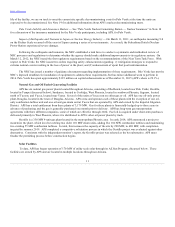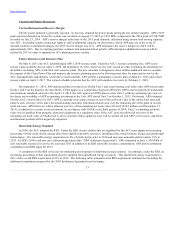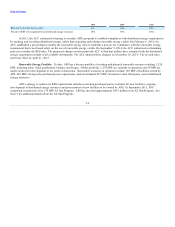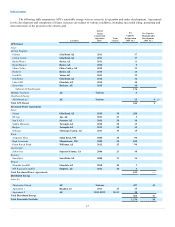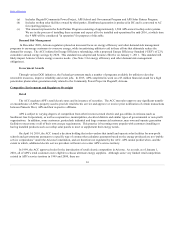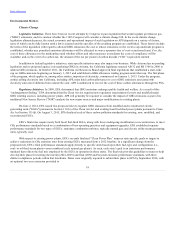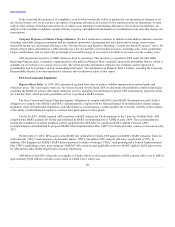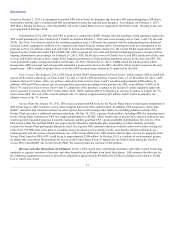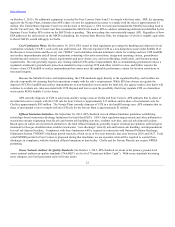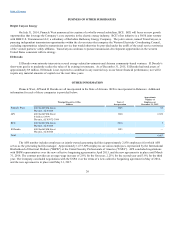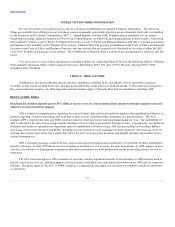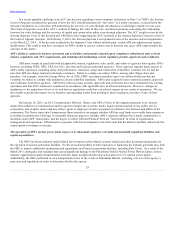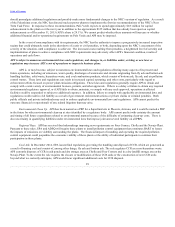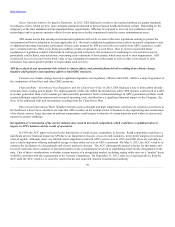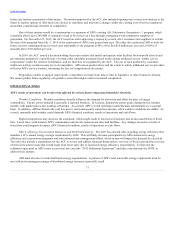APS 2015 Annual Report Download - page 24
Download and view the complete annual report
Please find page 24 of the 2015 APS annual report below. You can navigate through the pages in the report by either clicking on the pages listed below, or by using the keyword search tool below to find specific information within the annual report.
Table of Contents
closed on October 1, 2015), is unsupported and that EPA had no basis for disapproving Arizona’s SIP and promulgating a FIP that is
inconsistent with the state’s considered BART determinations under the regional haze program. Accordingly, on February 1, 2013,
APS filed a Petition for Review of the final BART rule in the United States Court of Appeals for the Ninth Circuit. Briefing in the case
was completed in February 2014.
In September 2014, APS met with EPA to propose a compromise BART strategy wherein, pending certain regulatory approvals,
APS would permanently close Cholla Unit 2 (which occurred on October 1, 2015) and cease burning coal at Units 1 and 3 by the mid-
2020s. (See Note 3 for details related to the resulting regulatory asset.) APS made the proposal with the understanding that additional
emission control equipment is unlikely to be required in the future because retiring and/or converting the units as contemplated in the
proposal is more cost effective than, and will result in increased visibility improvement over, the current BART requirements for NOx
imposed on the Cholla units under EPA's BART FIP. APS’s proposal involves state and federal rulemaking processes. In light of these
ongoing administrative proceedings, on February 19, 2015, APS, PacifiCorp (owner of Cholla Unit 4), and EPA jointly moved the court
to sever and hold in abeyance those claims in the litigation pertaining to Cholla pending regulatory actions by the state and EPA. The
court granted the parties' unopposed motion on February 20, 2015. On October 16, 2015, ADEQ issued the Cholla permit, which
incorporates APS's proposal, and subsequently submitted a proposed revision to the SIP to the EPA, which would incorporate the new
permit terms. APS is unable to predict when or whether APS's proposal may ultimately be approved by the EPA.
Four Corners. On August 6, 2012, EPA issued its final BART determination for Four Corners, which requires APS to install and
operate SCR control technology on Units 4 and 5 by July 31, 2018. (APS retired Four Corners Units 1-3 on December 30, 2013.) APS
estimates that its 63% share of the cost of these controls for Four Corners Units 4 and 5 would be approximately $400 million. In
addition, APS and El Paso entered into an asset purchase agreement providing for the purchase by APS, or an affiliate of APS, of El
Paso's 7% interest in Four Corners Units 4 and 5. Completion of the purchase is subject to the receipt of certain regulatory approvals
and is expected to occur in July 2016. In December 2015, NTEC notified APS of its intention to exercise its option to acquire the 7%
interest from APS. The cost of the controls related to the 7% interest is approximately $45 million, which will be assumed by the
ultimate owner of the 7% interest.
Navajo Plant. On January 18, 2013, EPA issued a proposed BART rule for the Navajo Plant, which would require installation of
SCR technology in order to achieve a new, more stringent plant-wide NOx emission limit. In addition, EPA proposed a “better than
BART” alternative and solicited comment on other options that could set longer time frames for installing pollution controls if the
Navajo Plant can achieve additional emission reductions. On July 26, 2013, a group of stakeholders, including SRP, the operating agent
for the Navajo Plant, submitted to EPA two suggested alternatives to BART, which would achieve greater NOx emission reductions and
result in greater reasonable progress toward the national visibility goal than EPA’s proposed BART determination. On July 28, 2014,
EPA issued a final Navajo Plant BART rule approving the alternative stakeholder plan. Depending on which alternate operating
scenario the Navajo Plant participants ultimately select, the required NOx emission reductions could be achieved by either closing one
of the three 750 MW units at the plant or curtailing energy production across all three units, such that the emission reductions are
commensurate with the closure of approximately one of the Navajo Plant units. APS estimates that its share of costs for upgrades at the
Navajo Plant, based on EPA's FIP, could be up to approximately $200 million. In October 2014, a coalition of environmental groups,
an Indian tribe, and others filed petitions for review in the United States Court of Appeals for the Ninth Circuit asking the Court to
review EPA’s final BART rule for the Navajo Plant. We cannot predict the outcome of this petition.
Mercury and other Hazardous Air Pollutants. In 2011, EPA issued rules establishing maximum achievable control technology
standards to regulate emissions of mercury and other hazardous air pollutants from fossil-fired plants. APS estimates that the cost for
the remaining equipment necessary to meet these standards is approximately $8 million for Cholla (excluding costs related to Cholla
Unit 2, which was closed
21


